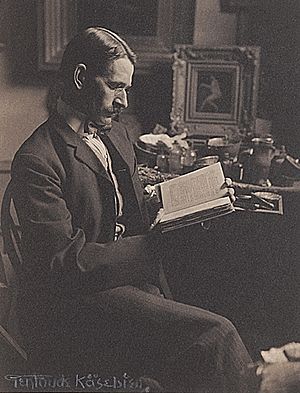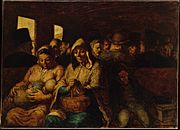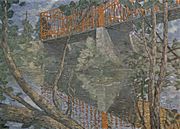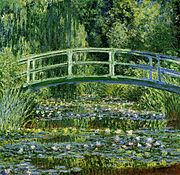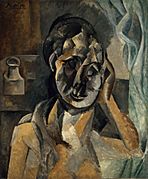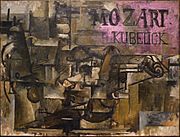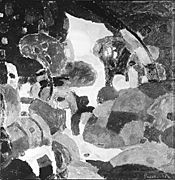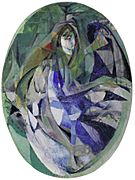Armory Show facts for kids
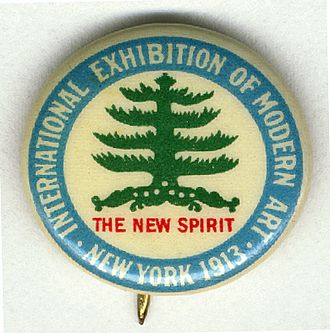
Armory show button, 1913
|
|
| Date | February 17, 1913 to March 15, 1913 |
|---|---|
| Location | 69th Regiment Armory, New York, NY |
| Also known as | The International Exhibition of Modern Art |
| Participants | Artists in the Armory Show |
The 1913 Armory Show, also known as the International Exhibition of Modern Art, was a very important art show. It was put together by a group called the Association of American Painters and Sculptors in 1913. This event was the first big exhibition of modern art in America. It was held in large spaces like the 69th Regiment Armory in New York City.
The show traveled to three cities. It started in New York City at the 69th Regiment Armory. This was on Lexington Avenue, from February 17 to March 15, 1913. After New York, the exhibition moved to the Art Institute of Chicago. Then it went to The Copley Society of Art in Boston. In Boston, there wasn't enough space, so all the art by American artists had to be removed.
The Armory Show changed American art forever. Americans were used to seeing realistic art. This show introduced them to new and experimental art styles from Europe. These included Fauvism and Cubism. The show helped American artists become more independent. They started to create their own unique "artistic language."
Contents
How the Armory Show Began


The idea for the Armory Show started on December 14, 1911. A group of artists met at the Madison Gallery in New York. They talked about the art scene in the United States. They wanted to create exhibitions for new and exciting art. This art was often ignored or rejected by other shows. The artists at this first meeting were Henry Fitch Taylor, Jerome Myers, Elmer Livingston MacRae, and Walt Kuhn.
In January 1912, Walt Kuhn, Walter Pach, and Arthur B. Davies joined with about 24 other artists. They formed the Association of American Painters and Sculptors (AAPS). Their goal was to "lead the public taste in art, rather than follow it." Other founding members included William J. Glackens, George Luks, and J. Alden Weir. The AAPS wanted to create new chances for young artists to show their work. They also wanted to teach the American public about art. Davies was the president of AAPS, and Kuhn was the secretary.
The AAPS members spent over a year planning their first big project. It was called the International Exhibition of Modern Art. It was a huge show, unlike anything New York had seen before. In the spring of 1912, they decided to use the 69th Regiment Armory as the main location. They rented it for $5,000, plus $500 for extra staff. It was also confirmed that the show would travel to Chicago and Boston later.
Choosing the Art for the Show
Once the location was set, the hardest part was choosing the art. The organizers decided to include a lot of new European art. Most of this art had never been seen by Americans. In September 1912, Kuhn traveled through Europe. He visited galleries, collections, and artists' studios. He arranged to borrow artworks from England, Germany, the Netherlands, and France.
In Paris, Kuhn met up with Pach, who knew the art scene there very well. Pach was friends with artists like Marcel Duchamp and Henri Matisse. Davies joined them in November 1912. Together, they got three paintings that became very famous and caused a lot of discussion at the show. These were Matisse's Blue Nude (Souvenir de Biskra) and Madras Rouge (Red Madras Headdress), and Duchamp's Nude Descending a Staircase, No. 2. American artists were invited to participate only after Davies and Kuhn returned to New York in December.
Pach was the only American artist closely connected to the Section d'Or group of artists. This group included Albert Gleizes, Jean Metzinger, and the Duchamp brothers (Marcel Duchamp, Raymond Duchamp-Villon, Jacques Villon). Pach helped get their works for the Armory Show. Many artists in Paris trusted Pach to bring their art to the exhibition.
Public Reaction to the Show
The Armory Show was the first and only exhibition put on by the AAPS. It featured about 1,300 paintings, sculptures, and decorative pieces. Over 300 avant-garde (new and experimental) European and American artists were included. Art styles like Impressionism, Fauvism, and Cubism were all shown.
The organizers wanted a lot of attention for the show, and they got it! They even published postcards of 57 artworks. News reports and reviews were full of strong opinions. People called the art "fake," "crazy," "immoral," and "chaotic." There were also jokes, cartoons, and mock exhibitions. The artist John French Sloan drew a cartoon called "A slight attack of third dimentia." It made fun of the Cubist paintings. Even former President Theodore Roosevelt said about the modern works, "That's not art!" However, the city authorities did not close the show.
The Metropolitan Museum of Art bought Paul Cézanne's Hill of the Poor (View of the Domaine Saint-Joseph). This showed that modern art was starting to be accepted in major New York museums. But for younger artists, Cézanne was already a well-known master.
Marcel Duchamp's brother, who used the name Jacques Villon, also showed his art. He sold all his Cubist drypoint etchings. New York art collectors liked his work and supported him for many years after the show.
The exhibition then traveled to the Art Institute of Chicago and The Copley Society of Art in Boston. In Boston, American artists' works were removed because there wasn't enough space. In Chicago, the show caused a scandal that even reached the governor's office. One newspaper headline read: "Cubist Art Will be Investigated; Illinois Legislative Investigators to Probe the Moral Tone of the Much Touted Art."
Layout of the Galleries

The Armory Show was divided into many galleries. Here's what each gallery featured:
- Gallery A: American Sculpture and Decorative Art
- Gallery B: American Paintings and Sculpture
- Gallery C, D, E, F: American Paintings
- Gallery G: English, Irish and German Paintings and Drawings
- Gallery H, I: French Painting and Sculpture
- Gallery J: French Paintings, Water Colors and Drawings
- Gallery K: French and American Water Colors, Drawings, etc.
- Gallery L: American Water Colors, Drawings, etc.
- Gallery M: American Paintings
- Gallery N: American Paintings and Sculpture
- Gallery O: French Paintings
- Gallery P: French, English, Dutch and American Paintings
- Gallery Q: French Paintings
- Gallery R: French, English and Swiss Paintings
The Armory Show's Impact and Legacy
The original Armory Show was a huge success. Many exhibitions have celebrated its importance throughout the 20th century.
For example, in 1944, the Cincinnati Art Museum held a smaller version of the show. In 1958, Amherst College showed 62 works, with 41 of them from the original exhibition. In 1963, the Munson-Williams-Proctor Arts Institute in Utica, New York organized a "1913 Armory Show 50th Anniversary Exhibition." This show included over 300 works.
Later, in 1966, a group called Experiments in Art and Technology (E.A.T.) was started. Engineers Billy Klüver and Fred Waldhauer teamed up with artists Robert Rauschenberg and Robert Whitman. They organized "9 Evenings: Theatre and Engineering." This was a series of performance art shows. Artists and engineers worked together to create performances using new technology. These shows were held at the 69th Regiment Armory. This was a way to honor the original 1913 Armory Show.
In February 2009, the Art Dealers Association of America (ADAA) held its 21st annual Art Show. It was held at the Seventh Regiment Armory in New York City. This exhibition also started as a tribute to the original 1913 Armory Show.
Since 1994, a new art fair called The Armory Show has grown. It's now held at the Javits Center and is a big annual contemporary arts festival.
Celebrating 100 Years of the Armory Show
Many exhibitions and events took place in 2013 to celebrate the 100th anniversary of the 1913 Armory Show.
The first exhibition, "The New Spirit: American Art in the Armory Show, 1913," opened at the Montclair Art Museum. It opened on February 17, 2013, exactly 100 years after the original show. The New-York Historical Society organized another exhibition called "The Armory Show at 100." It ran from October 18, 2013, to February 23, 2014. The Smithsonian's Archives of American Art created an online timeline. It showed documents from the original show's organizers.
A third exhibition, The Fountain Art Fair, was held at the 69th Regiment Armory itself. This was during March 8–10, 2013. The fair was inspired by Duchamp's famous "Fountain" artwork. The Art Institute of Chicago, which was the only museum to host the original show, displayed works from its modern collection that were in the 1913 exhibition. The DePaul Art Museum in Chicago also presented "For and Against Modern Art: The Armory Show +100." The International Print Center in New York held an exhibition of prints from the show.
The Greenwich Historical Society presented "The New Spirit and the Cos Cob Art Colony: Before and After the Armory Show." This show looked at how the Armory Show affected the Cos Cob Art Colony. It also highlighted artists like Elmer Livingston MacRae and Henry Fitch Taylor who helped create the show.
American filmmaker Michael Maglaras made a documentary film about the Armory Show. It was called The Great Confusion: The 1913 Armory Show. The film first showed on September 26, 2013, at the New Britain Museum of American Art.
Artists in the Armory Show
Here is a partial list of some of the artists whose work was shown at the Armory Show:
- Robert Ingersoll Aitken
- Alexander Archipenko
- George Grey Barnard
- Chester Beach
- Gifford Beal
- Maurice Becker
- George Bellows
- Joseph Bernard
- Guy Pène du Bois
- Oscar Bluemner
- Hanns Bolz
- Pierre Bonnard
- Solon Borglum
- Antoine Bourdelle
- Constantin Brâncuși
- Georges Braque
- Bessie Marsh Brewer
- Patrick Henry Bruce
- Paul Burlin
- Theodore Earl Butler
- Charles Camoin
- Arthur Carles
- Mary Cassatt
- Oscar Cesare
- Paul Cézanne
- Robert Winthrop Chanler
- Pierre Puvis de Chavannes
- John Frederick Mowbray-Clarke
- Nessa Cohen
- Camille Corot
- Kate Cory
- Gustave Courbet
- Henri-Edmond Cross
- Leon Dabo
- Andrew Dasburg
- Honoré Daumier
- Jo Davidson
- Arthur B. Davies (President)
- Stuart Davis
- Edgar Degas
- Eugène Delacroix
- Robert Delaunay
- Maurice Denis
- André Derain
- Katherine Sophie Dreier
- Marcel Duchamp
- Georges Dufrénoy
- Raoul Dufy
- Jacob Epstein
- Mary Foote
- Roger de La Fresnaye
- Othon Friesz
- Paul Gauguin
- William Glackens
- Albert Gleizes
- Vincent van Gogh
- Francisco Goya
- Marsden Hartley
- Childe Hassam
- Robert Henri
- Edward Hopper
- Ferdinand Hodler
- Jean Auguste Dominique Ingres
- James Dickson Innes
- Augustus John
- Gwen John
- Wassily Kandinsky
- Ernst Ludwig Kirchner
- Leon Kroll
- Walt Kuhn (Founder)
- Gaston Lachaise
- Marie Laurencin
- Ernest Lawson
- Henri de Toulouse-Lautrec
- Arthur Lee
- Fernand Léger
- Wilhelm Lehmbruck
- Jonas Lie
- George Luks
- Aristide Maillol
- Édouard Manet
- Henri Manguin
- Edward Middleton Manigault
- John Marin
- Albert Marquet
- Henri Matisse
- Alfred Henry Maurer
- Kenneth Hayes Miller
- David Milne
- Claude Monet
- Adolphe Monticelli
- Edvard Munch
- Ethel Myers
- Jerome Myers (Founder)
- Elie Nadelman
- Olga Oppenheimer
- Walter Pach
- Jules Pascin
- Francis Picabia
- Pablo Picasso
- Camille Pissarro
- Maurice Prendergast
- Odilon Redon
- Pierre-Auguste Renoir
- Boardman Robinson
- Theodore Robinson
- Auguste Rodin
- Georges Rouault
- Henri Rousseau
- Morgan Russell
- Albert Pinkham Ryder
- André Dunoyer de Segonzac
- Georges Seurat
- Charles Sheeler
- Walter Sickert
- Paul Signac
- Alfred Sisley
- John Sloan
- Amadeo de Souza Cardoso
- Joseph Stella
- Felix E. Tobeen
- John Henry Twachtman
- Félix Vallotton
- Raymond Duchamp-Villon
- Jacques Villon
- Maurice de Vlaminck
- Bessie Potter Vonnoh
- Édouard Vuillard
- Abraham Walkowitz
- J. Alden Weir
- James Abbott McNeill Whistler
- Enid Yandell
- Jack B. Yeats
- Mahonri Young
- Marguerite Zorach
- William Zorach
Women Artists in the Show
About one-fifth of the artists in the Armory Show were women. They came from both the United States and Europe. Many of these talented women artists have not received enough recognition since then.
Images for kids

-
Installation shot of the Matisse room, 1913 Armory Show. From the left: Le Luxe II, 1907–08; "Blue Nude (Souvenir de Biskra)", 1907; L'Atelier Rouge, 1911.
Selected Paintings and Sculptures
-
Eugène Delacroix, Christ on the Sea of Galilee, 1854
-
Honoré Daumier, The Third Class Wagon, 1862–1864
-
Édouard Manet, The Bullfight, 1866
-
James Abbott McNeill Whistler, Arrangement in Grey and Black: The Artist's Mother 1871. This famous painting was not in the Armory Show.
-
Pierre-Auguste Renoir, In The Garden 1885.
-
Mary Cassatt, Mère et enfant (Reine Lefebre and Margot before a Window), c.1902.
-
Vincent van Gogh, Self-Portrait, c. 1887.
-
Vincent van Gogh, Portrait of Adeline Ravoux 1890.
-
Vincent van Gogh, Mountain in Saint-Rémy, 1889.
-
Albert Pinkham Ryder, Seacoast in Moonlight, 1890.
-
Paul Gauguin, Nature morte à l'estampe japonaise (Flowers Against a Yellow Background), 1889.
-
Henri Rousseau, The Centenary of the Revolution, 1892.
-
Edvard Munch, Vampire 1893–94.
-
Paul Cézanne, Old Woman with Rosary, 1895–1896.
-
Julian Alden Weir, The Red Bridge, 1895.
-
Claude Monet, Water Lilies and Japanese Bridge, 1897–1899.
-
John Twachtman, Hemlock Pool, c.1900.
-
Henri-Edmond Cross, Cypresses at Cagnes, c.1900.
-
Paul Signac, Port de Marseille, 1905.
-
André Derain, 1912, Window on the Park (La Fênetre sur le parc).
-
André Derain, Landscape in Provence (Paysage de Provence) (c. 1908).
-
Odilon Redon, Le Silence, 1900.
-
George Bellows, Both Members of This Club, 1909.
-
Wassily Kandinsky, Improvisation 27 (Garden of Love II), 1912.
-
Maurice Prendergast, Landscape With Figures, 1913.
-
Henri Matisse, Madras Rouge, The Red Turban, 1907.
-
Henri Matisse, L'Atelier Rouge, 1911.
-
Pablo Picasso, 1910, Woman with Mustard Pot (La Femme au pot de moutarde).
-
Georges Braque, Violin: "Mozart Kubelick", 1912.
-
Albert Gleizes, 1910, La Femme aux Phlox (Woman with Phlox).
-
Albert Gleizes, L'Homme au Balcon, Man on a Balcony (Portrait of Dr. Théo Morinaud), 1912.
-
Marcel Duchamp, Nude Descending a Staircase, No. 2, 1912.
-
Marcel Duchamp, 1911-1912, Nude (Study), Sad Young Man on a Train.
-
Francis Picabia, Grimaldi après la pluie (believed to be Souvenir of Grimaldi, Italy), ca. 1912.
-
Francis Picabia, The Procession, Seville, 1912.
-
Robert Delaunay, Window on the City, No. 4, 1910-11 (1912).
-
Jacques Villon, 1912, Girl at the Piano (Fillette au piano).
-
Constantin Brâncuși, 1912, Portrait of Mlle Pogany.
-
Constantin Brâncuși, The Kiss, 1907-1908.
-
Constantin Brâncuși, Une Muse, 1912.
-
Andrew Dasburg, ca. 1912, Lucifer.
-
Raymond Duchamp-Villon, 1910–11, Torse de jeune homme (Torso of a young man).
-
Jacob Epstein, The Rock Drill, 1913, in its original form (now lost).
-
Antoine Bourdelle, Herakles the Archer, 1909.
Special Art Installation
The Cubist House (La Maison Cubiste)

At an art show in Paris in 1912, a special architectural display was shown. It quickly became known as Maison Cubiste (Cubist House). It was designed by Raymond Duchamp-Villon and André Mare with other artists.
This "Cubist House" was a fully furnished home. It had a staircase, metal railings, a living room, and a bedroom. Paintings by artists like Marcel Duchamp, Metzinger, Gleizes, Laurencin, and Léger were hung in the living room. It was an example of L'art décoratif (decorative art). It showed how Cubist art could be displayed in a modern, comfortable home.
Visitors to the Paris show walked through a large plaster model of the house's front. This model was 10 meters wide and 3 meters high. This architectural display was later shown at the 1913 Armory Show in New York, Chicago, and Boston. In the New York catalog, it was listed as "Facade architectural, plaster" by Raymond Duchamp-Villon.
See also
 In Spanish: Armory Show para niños
In Spanish: Armory Show para niños




